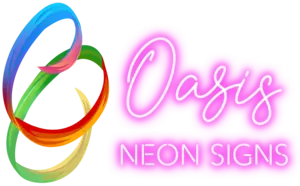
List of Neon Sign Colors: Science, Shades, and Applications
Share
Neon signs have maintained a prominent position in the commercial world. The word ‘neon’ evokes the image of American streets filled with neon sign eateries. These luminous lights are not just beautiful but have a profound chemical reaction taking place within to create a display of vivid colors. Gases and phosphors combine to create a plethora of brilliant displays of light.
If you are keen on exploring more about neon sign colors, then read further to understand the science behind their function.
The key elements of neon signage technology
It is vital to understand the working procedure of neon signs to know the results of the beautiful neon sign colors. Neon signs consist of rigid glass tubes that contain chemically stable inert gases only. When these gases are passed through alternate currents, the gaseous ions become energized to produce a beautiful glow. The colour emitted depends on the gas used and is also based on the phosphorous paste smeared on the inner surface of the tube.
Neon gas
This is a very commonly used gas in neon lighting. Neon gas produces a bright red-orange colour when an electric current is passed through it. This is because excited neon atoms only emit red and orange light radiation.
Though neon tubes are famous for their reddish-orange colour, their distinctiveness lies within the diversity of shades they exhibit depending on the different conditions accompanying the gas discharge process.
Argon Gas
Argon is yet another noble gas that finds use in neon signage. Argon on its own has a pale lavender-blue glow. However, when it combines with phosphor coatings, it gives rise to a wider palette of colors. As it is less reactive than neon, it serves as a stable light source for generating certain colors. Phosphors are also known to enhance Argon’s blue-violet light emission resulting in a display of colour forms.
Coatings of Phosphor
Phosphors emit radiation when they are excited. Within the neon sign tubes, the phosphor coatings convert the light emitted by gases into various colors. The final colour of a neon sign is greatly influenced by the choice of phosphor paste used to coat the glasses. Some Phosphors can receive ultraviolet light and re-emit it as visible light. This provides a wide range of colors rather than what gas alone could provide.
What are some neon colors?
Each neon sign colour is a result of a specific combination of gases and phosphor coatings. Here is a detailed look into the neon colors.
Red
It is red – the most traditional colour of neon signs. Only the red portion of the spectrum is emitted by neon atoms when they are electrically excited. This produces the striking and distinctive deep glow that many people associate with neon signs.
Red is a popular colour for advertisements and is attention-grabbing signage. You can expect true-tinted colors varying from bright scarlet to deep crimson depending on the amount of pure neon gas present and the amount of voltage applied.

Blue
This is another popular neon sign colors. Blue neon colour is generated with Argon gas when it combines with Phosphor paste. Argon itself emits blue-violet light upon ionization. However, using Phosphor paint enhances the stability and intensity of the light being emitted.
As a result, deep blue hues are seen in many modern neon displays. These hues are excellent for any signage that aims to convey professionalism or serenity because of their relaxing effect. Such differences in phosphor coating can result in a variety of blues, such as vibrant azure or dark navy.

Green
The green neon sign is formed from Argon gases mixed with certain phosphor coatings. As phosphor coating absorbs Argon light and reflects it as green, it looks extremely vibrant. This combination makes it possible to create the striking green colour that is frequently used in signboards and other décor.
Green is often associated with renewal and development; this explains why environmental and wellness-focused sign boards frequently use it. Moreover, the phosphor content of different greens results in a range of colors, from light mint green to strong lime green.
Pink
The manufacturing process of pink neon signs is more sophisticated. This is because they are produced through a combination of neon gas with an additional phosphor layer. The neon gas provides the basic color, while the phosphor material renders a more attractive pink colour to the sign. The colour pink has been associated with cheerfulness and is a common sign used in shopping centers and clubs.

Orange
The orange neon light color is produced with neon gas and a combination of special phosphor coating. Neon gas can produce a red-orange shade when an electric current is passed through it. however, the use of phosphor coating makes it possible to have a pure and consistent colour. As orange indicates enthusiasm and energy, it is a popular choice for those who wish to convey excitement and energy. The orange hue produced by neon gas and phosphor coating varies from dark amber to bright tangerine.

Yellow
These neon signs are made from Argon or Neon gas using phosphor coats. The yellow spectrum is where the coating absorbs the light emitted from the gas. In this process, a bright yellow colour is produced which grabs attention easily.
It is often used in directional signs and for highlighting. Yellow signifies clarity and caution. It is an efficient choice when it comes to grabbing someone’s attention and providing distinct information.
Purple
Argon gas and phosphor coating that emits purple light are used in making purple neon signs. The phosphor coating changes the base colour of Argon gas and results in a unique shade of purple. Although it is not used widely, it contributes to a unique and elegant signage. Purple colour is often perceived as a symbol of luxury or creativity. This makes it common in figures of art and extravagant business establishments.
White
White glowing neon signs are produced by applying phosphor coating over Argon gas. These neon signs serve as general lights. They provide clean-looking, bright illumination. Using white neon lights encompasses functioning lighting plus decorative highlights amidst others. It may differ from cool bluish-white to warm amber-toned depending on the kind of phosphor combination used while designing.
Turquoise
These neon signs originate from phosphor-coating covering Argon gas. The light released by Argon gas gets modified by Phosphor coating and results in a unique bluish-green hue. Of all neon light colors, turquoise adds a refreshing touch, sophistication, and serenity to neon signages. Based on the composition of the phosphor coating, the hue varies from pale sea foams to deeper teals.
Amber
Amber neon signs specifically consist of neon gas coated with phosphor which results in an amber hue. When neon gas is illuminated, it undergoes coloration by phosphor to produce amber light. This light is warm and has a welcoming glow. This kind of light is associated with memories it brings back from good old days. Hence, it is commonly used in retro-styled billboards and lighting around.
The evolution and application of neon colors
Neon signs have experienced major transformations from the times they were first created. These were utilized initially for marketing and commercial purposes alone. Current neon signage finds itself being utilized in an assortment of applications that range from artistic installations to architectural lighting.
Historical context
At the beginning of the 20th century, neon signs gained popularity, and they have continued to be popular ever since. However, their earliest commercial application dates back to 1910 in Paris. People quickly became accustomed to the gas's unique glow. This resulted in its widespread use in the signs and advertising industries.
Neon signs have come to represent the lively environment and thriving nightlife of cities over time. As a result, new hues and technological advancements have emerged, leading to the creation of intricate and artistic applications.
Present-day applications
Neon signs are still popular today because they are flexible and due to their aesthetic appeal. Artists and designers use these lights to create striking installations and artwork. These are used in architecture to create dynamic lighting effects and highlight specific features of structures. Moreover, neons have a nostalgic appeal. These retro-styled signs and decorations are being increasingly used. They are combined with other lighting technologies to create inventive and captivating visual effects.
Technological advancements
Neon sign technology is constantly improving in terms of both visual appeal and utility. Most modern neon signs are fitted with sophisticated electrical controllers. This allows them to show dynamic and customizable lighting effects.
Neon signage is more versatile in its use as it may be utilized for a wide range of purposes. The development of new materials and processes ensures longevity and energy efficiency. The attractiveness of neon signs finds them a place in décor and illumination.
Conclusion
The colors that are used in neon signs are nearly universally used to indicate different types of illumination. The traditional red hue of neon gas has grabbed the attention of artists and mediators. More recently, phosphor-coated versions have become popular globally due to their variety of hues. This deeper understanding of how neons perform scientifically is sure to advance our knowledge of neons in general.
If you want to play around with different neon sign colors and design your personalized neon you can do this with the help of help of Oasis Neon Sing and our free neon sign designing tool.

